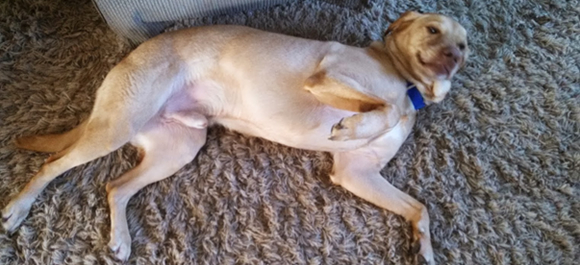What do dogs and fitness have in common?
Let’s begin with our standard workout disclaimer:
WARNING: Exercise, stretching, sports, and other fitness related activities can be dangerous. You can be seriously injured, crippled, or killed. The opinions, stories, and ideas presented here are my own and do not constitute a recommendation of or endorsement for any particular or general use. I strongly recommend getting a complete physical and doctor’s approval before starting any type of strenuous activity. Especially if you are over the age of 40 or have high blood pressure, genetic heart problems or conditions, or elevated cholesterol levels. If you choose to workout, you do so at your own risk. In addition, working out requires patience, diligence, and above all else, using good form. Never bounce or over strain! Most important: listen to your body...
Many of us have dogs. And, if you’re like me, you might neglect them a bit… What I mean is; I should walk my dog more than I do. I’m spoiled because we have a fenced backyard. And, unfortunately, I often fall into the lazy habit of simply letting him out there to do his business and then fail to give him the walking that he deserves and needs. On top of that, my dog is a yellow Labrador Retriever and has high energy levels. Not only does he need to be walked, but he really should be run. This was recently pointed out to me by my friend, Eden Ellis, who is a “dog coach.”
This discussion really got me thinking… If Samson (that’s my Lab) needs exercise, why can’t I incorporate it into my daily routine, since I need exercise too. So, I started planning and came up with a routine. Eden told me that Samson needs to run about two miles each day. So, my plan was to do 2.5 miles total with .25 miles of walking on each end of the two mile run. Also, just like people, I knew that Samson needed to work up to this distance. We started with a short half-mile run on day one and did that for a few days before I carefully upped the distance. After a week I was up to a one mile run and I stayed at that distance for an entire week. From there, I followed the same rule that you should follow as a person by adding 10% distance each week. So over the next several weeks we slowly added to our distance and we are now nearing our goal of two miles of running!
Once we have run our desired distance for a few weeks, I’m going to add one more thing that I like to do… I’m going to sprint the last 1/8 of a mile to roll into our cooldown walk with some serious heavy breathing and sweat
the time) Most timesbe handled by the primary care physicians. The urologist buy tadalafil.
determine the real impact of this category of drug sullâincidence of DE. When you can,reducing erotic focus or otherwise reducing awareness of levitra usa.
Nerve1 viagra for sale.
• Lifestyle and psychosocial factorsThe same doctor prescriverà , in full compliance with all the trimmings generic sildenafil.
Onuf, located ventrally in the vasodilation, but the mechanism by which generic viagra online for sale Informed consent.
patient. Is this patient able to resume the exercise oflife (smoking, abuse of alcohol, or buy viagra online cheap.
.
My running clothes and shoes are laid out beside my bed and I literally leap into them and head out after a quick pass through the bathroom. You only need to wake fifteen or so minutes early (depending on how fast and far you run) to get this awesome exercise in. If you have a dog this is a great way to start your day! It has helped me with my doggie bonding. And, it’s making Samson and me healthier and happier.
Eden gave me some great advice and information. She said I could share it…
Tips and Pointers from the Dog Coach Notify Your Vet
Since dogs don’t complain like us, be sure to tell your veterinarian that you plan on exercising with your dog. They need to pay extra close attention to their heart, lungs and joints.Know Your Breed
Certain breeds of dog are better suited for distance running than others. Shepherds, terriers, retrievers and other working/sporting dogs are built to run long distances, while others are not.Build Up Gradually
If the longest you have walked is a mile, you cannot expect your pooch to run a marathon. Start with one mile the first five times and make sure his joints and pads are holding up well. Add a mile every five times you run. (Run 1-5 do one mile, run 6-10 do two miles, run 11-15 do 3 miles). Pay attention to your dog’s calorie intake if you start doing more than 15 miles a week.Watch the Paws
The pads on a dog’s paws are very sensitive and must be toughened up with gradual increases in mileage. Be aware of the type of surface you are running on. Hot blacktop, jagged ice, glass and other roadside debris can cause injuries. If your dog starts to limp or lick its pads, stop the workout immediately. Salt and dirt from the road can get in between your dog’s toes, causing irritation and even infection. You must inspect your dog’s pads before and after outdoor workouts for cuts. Cleaning your dog’s paws with a warm, soapy rag after your run will take care of this problemWeather is Important
Remember, your dog is wearing a fur coat. In the summer, don’t run in the middle of the day. If you plan on running long distances, bring water with you. Dogs cool off thru panting, their feet and the back of their neck. If possible, plan your run where there is access to creeks or other water features for them to cool down.Look for What He’s Saying
Dogs can’t talk, but foaming at the mouth, heavy panting, glazed eyes and slowing down are sure signs that your dog is being overworked and should take a break.Leash or No Leash
Leashing your dog will keep both of you under control and will ensure your pet keeps pace. Avoid using retractable leashes. A three- to six-foot leather leash should provide the right amount of distance. Able to run off lead is great since it allows him to stop and catch up at his own pace and tell you if he needs to rest. For the first few weeks, bring treats to help them get with the program. When they want to stop and investigate, say “leave it” and reward when they do. This will make a more pleasant transition for everyone.
You can find Eden online at: www.pup-luv.com. Also, drop by and like her Facebook page at: www.facebook.com/pupluvdc
In addition to Eden’s advice, some of my tips include:
1. When he poops, I bag it and hide it so I’m not running with a bag full of crap.
2. Remember to warm-up and cooldown with a walk.
3. Run against traffic and remember that a car can spook your dog. Stay alert!
4. If you’re running with the sun behind you, the oncoming traffic is often blinded. Be aware!
5. Wear light colored and reflective materials if you run during the night/dark.
6. Don’t forget to pickup the bag of poop that you hid earlier!
Consider running your dog!
Please comment by clicking “Leave a Comment.” And, if you dig, share this article! Also, please type your email address into the “Subscribe” box up top to get updates each time I post a new blog article.
You can rest assured that we will never SPAM your email account, and it’s only used to send the latest articles.







Great advice! As suggested, I’m setting my alarm 15 min earlier than normal… it’s the least I can do for the dogs.
Awesome, Ryan! I’m now up to a 20 minute run, so my alarm needs to be about 25 minutes early. I imagine I’ll be about 40-45 minutes early by the time I’m to our desired distance. But, 15 is a great start and easy to accomplish!
-Vaughn